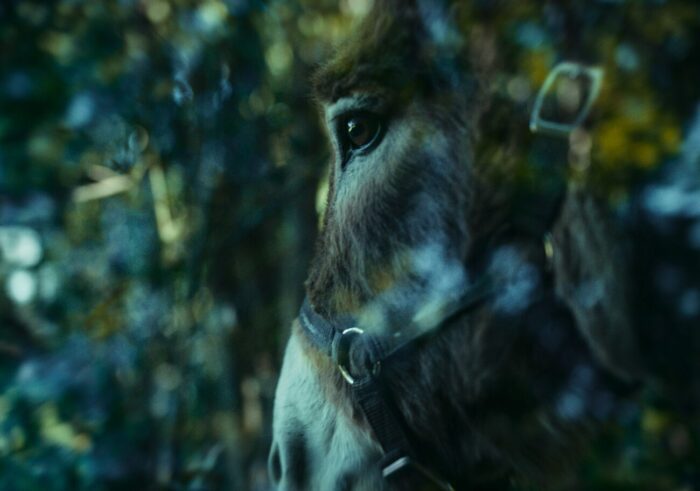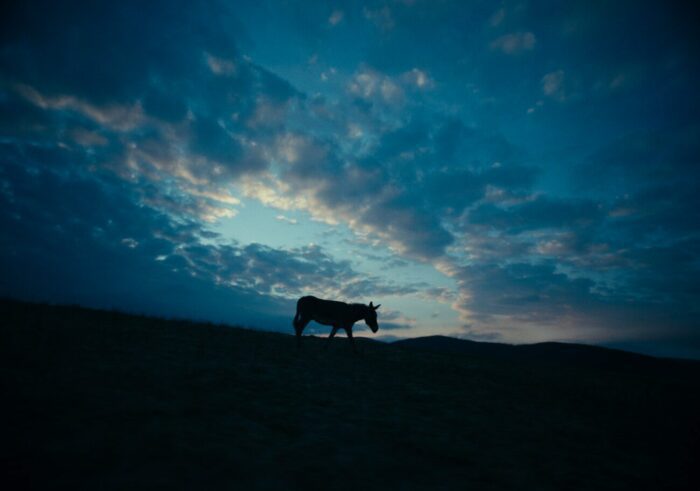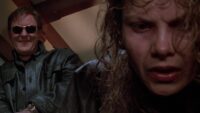From Chaplin’s Tramp to Holly Hunter’s Ada to WALL*E, a mute protagonist can express volumes. Such is the case in Poland’s official submission for Best International Feature at this year’s Academy Awards and a Jury Prize Winner at Cannes, EO, a visually astonishing and intellectually challenging film shot from its titular donkey’s perspective. EO, the donkey known only by the sound be makes, makes for an expressive protagonist as he travels the European countryside, witness and subject to the best and worst of humanity along the way.

The film is a remarkable triumph for its team—director and writer Jerzy Skolimowski, co-writer Ewa Piaskowska, and cinematographer Michal Dymak—who lean into the past for inspiration in echoing Robert Bresson’s classic Au Hasard Balthazar yet remain rooted in the travails of the contemporary. Bresson too employed a donkey as his protagonist Balthazar, cuffed about from one callous owner to the next, to profound emotional effect (the film is ranked #25 in Sight & Sound’s recent Greatest Films of All Time Critics’ Poll). So too does Skolimowski focus on a wayward donkey whose exploits convey more about humanity than many films with human protagonists.
Bluntly alluding to an acknowledged masterwork like Balthazar might be an act of hubris for some, but Skolimowski—a veteran director now active in his seventh decade of directing!—directs EO’s tale with confidence, establishing a basic road-movie narrative with some wild, trippy visuals. The film begins awash in a deep lurid flashing red as EO, at center ring in a circus, is led dutifully through a series of tricks by his caring trainer Kasandra (Sandra Drzymalska). Despite the lighting, EO seems serene and comfortable, his large eyes gazing directly and, we assume (through the Kuleshov effect Skolimowski puts to apt use throughout) lovingly at his human.

It’s a peace that won’t last, at least not when activists appear to protest the circus animals’ alleged mistreatment. Their success bankrupts the circus, the animals are abandoned (good work, animal rights activists!), and EO is left, more than a little like Bresson’s Balthazar, to his own limited devices. It’s not exactly a picaresque adventure. EO’s path leads him across a countryside often ravaged by humans’ impact on the environment. He encounters hunters in the woods, as the green light of their rifle scopes posing an immediate threat. He bears witness to one of their victims, slowly bleeding out, and it’s impossible not to register his silent gaze as both concern and fright.
Similar tales are told in films like Spielberg’s War Horse and DisneyNature’s excellent series of anthropromorphized documentaries like Polar Bear. Except that it’s clear, especially from Dymak’s evocative, often experimental, but almost always beautiful camerawork, that the purpose here is not to map human emotions onto an animal protagonist or progress towards an emotional reunion. Smolikowski’s vision is much darker than that—and than Bresson’s.
So while on the surface the tale of a charming donkey, cast out from his home, wandering the countryside might seem like an innocuous tale, Smolikowski is after something else entirely. When EO blithely happens upon a football match decided by a failed penalty kick, the winning team, saved from near-certain defeat, takes EO’s appearance to be an omen of good luck. The losing team, though, wants vengeance, and brings cricket bats to enact revenge on the winners—and their lucky-charm donkey.
It’s a moment that is profoundly traumatizing. I yelled at my screen louder than I can remember. Do not take your young children to see EO. But if you survive, you’ll be forced to contemplate humankind’s vast, unending capacity for mindless violence, our willingness to maim and kill for our emotions, ignited by so little as a ball hitting or missing a crossbar. The scene doesn’t really show much in terms of wood against flesh and fur—and of course the filmmakers declare no animals were injured—but it’s as disturbing as any I recall.
I don’t think it’s a spoiler to reveal that a badly beaten EO survives, even if by some miraculous rescue. Smolikowski then segues, curiously, to a sequence of a robot dog struggling to stand after having been flipped on its back. The sequence is oddly affecting, even if its exact intentions are difficult to discern. Is EO dreaming, his spirit willing himself to recover? Is Smolikowski suggesting that EO’s biological hard-wiring is kicking in, just as it would in a human-created robot made from circuits and wires? Either way—or there may be others—the curious sequence ends as abruptly as it began, and EO is back onscreen with his human rescuers.

Viewers of the sort who need exact narrative continuity, every scene explicable and logical, will find scenes like this frustrating. Another has EO meandering the countryside for a time, then the perspective taking to the sky for a long aerial flight along a river swathed in a hellish crimson red. Is this drone sequence related to EO’s journey? It’s impossible to know for certain. But these are all a part of the film’s distinct visual style. In this way, EO takes a radical departure from Au Hasard Balthazar, a film heralded for the simplicity and directness of its cinematography and narrative.
In other scenes, EO‘s cinematography may be more conventional, but it’s never anything other than evocative. The squarish frame (it’s shot in Academy aspect ratio) keeps EO’s perspective limited. The shallow-focus, wide-angle close-up used often makes for an intimate connection between EO and viewer, especially when his soulful, dispassionate gaze is the focus (and the rest of the screen well out of focus). And EO makes for a sweet, charming protagonist, one whose witness to humanity’s foibles makes us confront our own failings in clever, unprecedented ways.
Along his journey, EO meets up with a young Italian priest (Lorenzo Zurzolo), a Countess (Isabelle Huppert), and a host of others. Any human may pose EO a threat, just as any human EO encounters may be a target themself. The film does not imply whether he is cognizant of human’s intentions or the consequence of their actions, but it’s impossible not to be beguiled by our asinine protagonist. Even when he witnesses humanity at its worst, you’ll desperately want this charming soul to survive the treacherous world he wanders.
EO makes its North American theatrical debut at the Gene Siskel Center in Chicago, IL, Friday, December 9.



